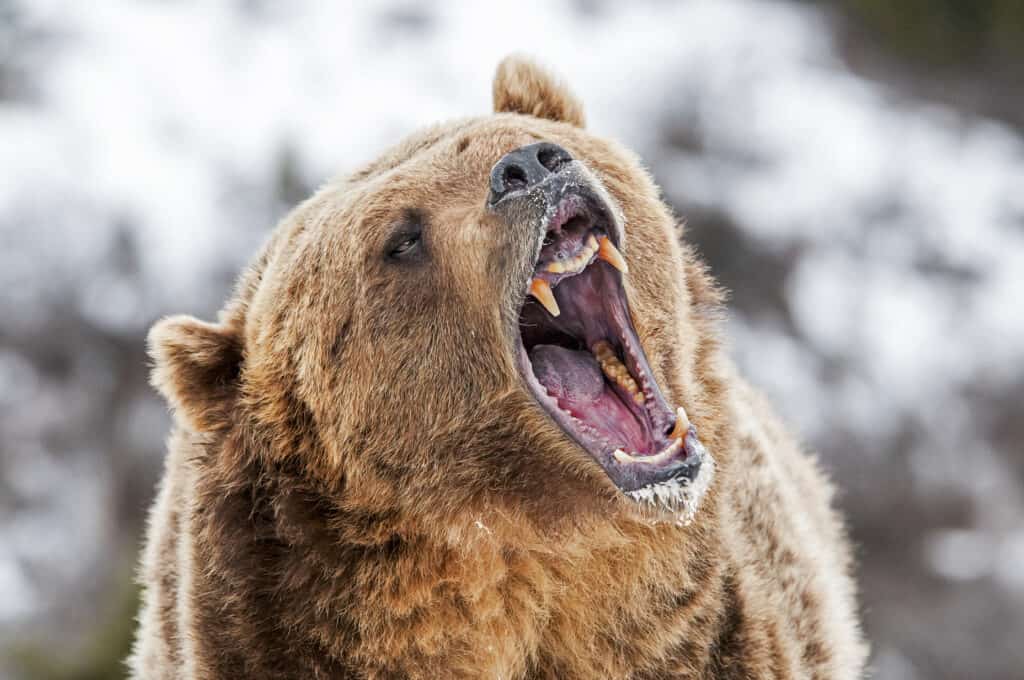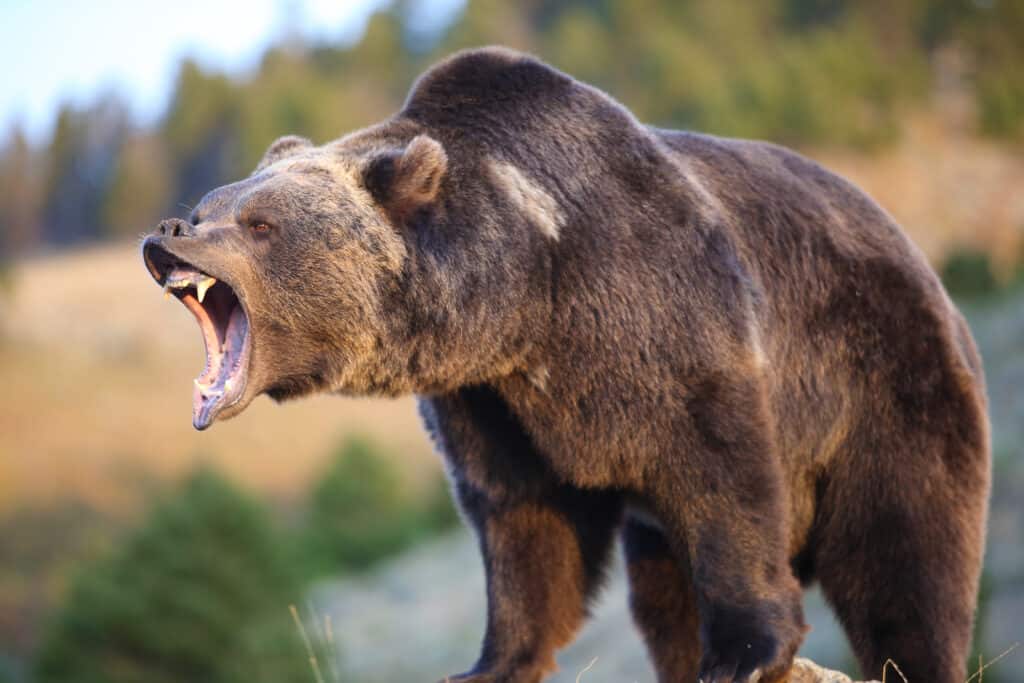The grizzly bear is one of the Earth’s largest and most ferocious animals. They have long claws, heavy builds, massive muscles, and ferocious teeth. Their claws are two to four inches long and razor-sharp, enabling them to dig the ground and claw their prey to death.
Like polar bears who use their teeth to catch fish, grizzly bears also use their teeth to catch and kill prey. This article uncovers everything you’ve ever wanted to know about grizzly bear teeth. Let’s go!
The Structure of a Grizzly Bear’s Teeth

Grizzly bears have two more molars on their bottom jaws than on their upper jaws.
©Scott E Read/Shutterstock.com
Grizzly bears have canine teeth or fangs, incisors, premolars, and molars. On their upper jaws, they have two canine teeth or fangs (one on each side), six incisors (three on each side), eight premolars (four on each side), and four molars (two on each side.)
On their lower jaws, they have two canine teeth or fangs (one on each side), six incisors (three on each side), eight premolars (four on each side), and six molars (three on each side.)
The major difference is that they have two more molars (one extra on each side) on their bottom jaws than on their upper jaws. In total, grizzly bears have 42 teeth.
What Do Grizzly Bears Use Their Teeth For?
Grizzlies have teeth that enable them to tear through flesh, as well as crush and grind plants. These omnivorous animals have quite a varied diet and are adept hunters.
Grizzly bears have premolars with flat crowns, making them perfect for crushing and grinding. Their molars are also used to chew and crush but have an added function. Since they have two more molars on their bottom teeth, there is a slight imbalance which leaves a gap or a diastema.
Humans also have diastemas which usually occur between the two front teeth. In many herbivores such as bears, diastemas are present in the molar area, and this is for a special reason. Plant eaters experience a lot of wear in their teeth, especially compared to meat eaters. This is due to the texture of plants and because herbivores and omnivores need to eat more than carnivores.
Grizzlies’ diastemas allow them to grind food properly between their tongue and the upper palate. They can also move their food around with their tongues without discomfort because of how their teeth are placed.
Grizzly bears also have really sharp incisors, which help them tear through strong flesh or tree barks and occasionally grass.
Another important way that bears use their teeth is to carry their young. Mother bears often use their teeth to move their cubs. They are extremely protective of their babies for at least two years.
What is a Grizzly Bear’s Bite Force?

Grizzly bears have a bite force of 975 pounds per square inch.
©Dennis W Donohue/Shutterstock.com
Grizzly bears have a bite force ranked at 975 pounds per square inch, second only to the polar bear, with a bite force of 1200 pounds per square inch. Grizzly bears have stronger bite forces than lions, who have a bite force of about 650 pounds per square inch.
Baby Grizzly Bear Teeth
Baby bears begin to develop teeth in a way similar to how human babies do. They start with deciduous canines in the same way human babies start with their bottom incisors. Next, baby bears or cubs develop incisors and then molars. These teeth are called deciduous, or milk teeth and are fully complete by the time the cubs are 18 months old.
Grizzly bears do not regrow lost teeth. Most mammals have only one set of milk or deciduous teeth and one set of permanent or adult teeth. Other mammals, such as mice, have only one set of teeth throughout their lives.
Telling a Grizzly Bear’s Age by Its Teeth
When bears hibernate, a ring of dark pigment forms across their teeth. Each year, a new ring is added, allowing you to tell a bear’s age the same way you can tell a tree’s through its rings. However, the only way to actually be able to count these rings is if the bear loses its teeth, as they are not exactly welcoming to closeup checkups.
Telling a Grizzly Bear’s Temperament Through Its Teeth
According to the National Park Service, teeth clacking is one very common sign of an impending bear attack. If a bear begins to clack its teeth and pound the ground with its paws, that’s a warning sign. Many people have been attacked after such gestures.
Bears also display or bare their teeth as a warning sign. They do this by pulling back the muscles in their muzzles and drawing their noses back, which enables them to raise their upper lip and bare their teeth.
How Do Grizzly Bears Use Their Teeth To Hunt?

Grizzly bears chase after prey and sink their teeth into their backs.
©MattCuda/Shutterstock.com
Grizzly bears use various parts of their bodies for hunting. Their sharp and long claws make their paw swipes deadly, and their sheer force is terrifying. Grizzlies also use their teeth when going after prey, especially fast-moving prey.
They chase prey and sink their teeth into their backs, piercing through their skin and often breaking their spines.
Do Grizzly Bears Bite Humans?
Grizzlies have been known to attack humans, especially in the wild. These occurrences aren’t common, but they do occur, and it’s a great idea to know what to do in the case of an attack.
If a grizzly bear attacks you, play dead. Do not fight back, as that usually worsens the attacks. The NPS advises this to prove that you are not a threat. Instead of fighting, lay down flat with your backpack on for protection and keep your legs spread.
However, this doesn’t always work, and the attacks sometimes become more violent. In such a case, you should fight back with everything you have. Aim your punches and kicks directly at the bear’s face, and do not relent. If you can, grab rocks, sticks, and anything else you can use to defend yourself. If you do this well enough, the bear just might back down.
If this doesn’t alleviate your worries, you might want to stay away from the woods of Montana, Idaho, Washington, Wyoming, and of course, Alaska.
Up Next:
Grizzly Bear Lifespan: How Long Do Grizzly Bears Live?
Discover The Largest Grizzly Bear Ever
10 Incredible Grizzly Bears Facts!
The photo featured at the top of this post is © Falade Adewale/Shutterstock.com
Sources
- Denver Zoo, Available here: https://denverzoo.org/animals/grizzly-bear/
- National Park Service, Available here: https://www.nps.gov/articles/bearattacks.htm
- North American Bear Center, Available here: https://bear.org/skull-of-a-black-bear/
Thank you for reading! Have some feedback for us? Contact the AZ Animals editorial team.






